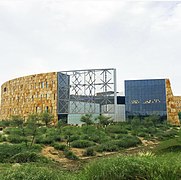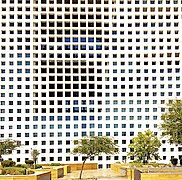Architecture of Qatar
| Part ofa serieson the |
| Culture of Qatar |
|---|
 |
| History |
| Languages |
| Cuisine |
| Religion |
| Musicandperforming arts |
| Sport |
Thearchitecture of Qatar,similarly to otherPersian Gulfnations, is strongly influenced byIslamic architecture.Qatariarchitecture has retained its Islamic essence, evident in the unadorned, humble designs of its mosques. This tradition extends to other buildings, which feature many decorative elements such asarches,niches,intricately carved plaster patterns,gypsumscreens (kamariat and shamsiat), andbattlementsatop walls and towers.[1]
The country'shot desert climateheavily influenced the selection of building materials in traditional architecture. Roughstones,sourced from rocky hillsides or coastal areas, were commonly used. These stones were systematically arranged in rows, withclayfrom thePersian Gulfserving as the binding agent. This clay was also employed to coat wall surfaces, both inside and outside, and to fill the gaps between stones.Ceilingswere similarly covered with clay. In situations where stones were scarce,mud brickswere sometimes substituted. As construction techniques evolved, clay, which was unsuitable for the rainy winter season, was gradually replaced withgypsummortarfor plastering walls. Various types ofwoodwere incorporated as well, particularly woodenbeamsfor supporting ceilings.Limestone,quarried from nearby rocky hills, was also occasionally used.[2]
Types of traditional architecture[edit]
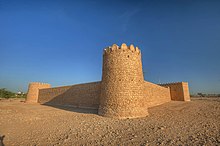
Qatar's architectural heritage, like that of otherArabian Peninsulacountries, includes buildings from the 17th to early 20th centuries, with at least one surviving structure dating hundreds of years earlier:Murwab Fort.Qatari architecture is categorized into three main types: religious, civil, and military.[3]
Religious architectureincludesmosques,which serve as places for the five daily prayers and the Friday congregational prayer.Mosques in Qatarare characterized by their simplicity and modesty yet will occasionally contain attractive ornamentation.[3]
Included among civil architecture arepalaces,housesandmarketplaces.Palaces were grand structures that housed local rulers and displayed a high level of opulence. Homes for both the nobility and common people were constructed from clay and stones. Noble homes were typically large, while commoners' houses were smaller. Initially, markets (also known assouqs) consisted of rows of wooden pillars covered with fabric or burlap. Over time, they evolved to include structures made of stone and clay, forming two rows of shops facing each other.[3]
Military architecture consists offortressesanddefensive walls.Fortresses were often built along the borders, and featured watchtowers at the corners and various rooms along the interior walls, resembling castles. Large defensive walls made of stone and clay often enclosed settlements, with main gates that were closed at nightfall. Towers were erected at intervals along these walls for added defense.[3]
Climatic and regional adaptations[edit]
The architecture in Qatar has been significantly shaped by climate and environmental factors, which have influenced the design and variety of buildings, including houses, mosques, forts, and marketplaces.[4]
Due to the region'sdesert climate,which features minimal rainfall in winter and high temperatures and humidity in summer,flat roofsare predominant instead ofpitchedones. To mitigate the heat, architects designed shaded areas adjacent to mosques and houses, which open directly ontocourtyards.The intense sunlight led to the use of relatively small lighting openings compared to the expansive exterior walls.[4]
Residential buildings in Qatar and the Gulf region often feature rectangularwindows(darisha) that open onto the courtyard. In living rooms (majlis) and upper-floor rooms, windows typically face both the courtyard and the road. Additionally, for ventilation and lighting, other openings known asbadjeerare commonly constructed in upper rooms but are rarely found in lower ones.[4]

Coastal Qatari architecture shows influences fromIranian architecture,while inland architecture is more reflective ofNajdistyles, particularly in fortified houses found inAl Rayyan,Al Wajbah,andUmm Salal Mohammed.Coastal villages likeAl JumailandAl Wakrahdemonstrate the adaptation of inexpensive Persian Gulf models, with houses constructed from local materials likehasa(rubble) andjuss(limestonemortar). The architecture of these areas was designed to benefit from on-shore breezes and to meet the economic needs of the inhabitants which comprisedfishingandpearling.For instance, Al Wakrah contains more historicwind towersthan any other settlement in the country.[5]
Houses[edit]
Layout and design[edit]
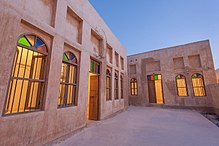
Qatarihouses,the smallest urban units, are centered aroundcourtyards,which serve as venues for family functions. These courtyards provideventilation,sunlight, and a private space for domestic activities and social interactions. The number of courtyards varies based on family size and wealth. Surrounding the courtyard are multifunctional rooms used for sleeping, eating, and socializing, with their usage depending on the season and climatic conditions.[5]
Privacyand territoriality are key considerations in Qatari house design. Spaces aresegregatedto separate male visitors from the family and young men from women. Themajlisalways has a separate access route to maintain privacy. As families grow, new plots and access points are established. Houses typically feature flat roofs to provide shade, with small window openings to reduce heat.Badjeerventilation openings are common in majlis and upper rooms, enhancing airflow and comfort. The design of Qatari houses includes shaded areas liketerracesandverandasto provide comfortable spaces for outdoor activities.[5]
Privacy[edit]
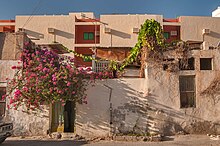
In Qatari architecture, houses are viewed as a private entity, meant to be discreet and unassuming from street view. Typically, only one external wall faces the street, and it is designed to maintain privacy, often featuring minimal openings. Anywindowsordoorsare screened to prevent outsiders from seeing into the household's private areas. Privacy is a fundamental principle in Islamic societies, reflected in the separation of male and female spaces within the home. Regardless of a house's size, maintaining privacy remains a crucial aspect of its design.[5]
Guests[edit]
Qatari residential developments often feature extensive internal and external spaces. The men's section of the house usually includes accommodations forguests,with some homes providing a guest room and bathroom facilities. In other cases, guests might sleep overnight in the majlis, a traditional sitting area. This design reflects the importance of hospitality and the majlis in Qatari homes.[5]
Majlis[edit]

In traditional affluent Qatari households, themajlisserved as one of the most significant spaces.[6]This formal, gender-specific reception area was utilized for hosting visitors, conducting business, and leisure activities. The majlis also functioned as a forum for social interaction, discussion, andconflict resolution,with a particular emphasis on the wisdom and authority of elder members.[7]These gatherings occasionally served as platforms for various forms of folk arts. In the past, the "dour", or spacious rooms designated for these gatherings, hosted seafarers,dhowcaptains (noukhadha), and enthusiasts of folk arts betweenpearl fishingseasons. Here, they engaged inal-samra,evenings of song and dance, celebrated during weddings and other occasions for entertainment.[8]The majlis represented the homeowner's temperament and status, and it continues to hold an essential communicative role within Qatari society, facilitating interactions with outsiders.[6]
Typically, the majlis was a designated room near the courtyard entrance, allowing guests access without intruding into the private parts of the house. It was often the only room with windows facing the street and was the most elaborately decorated area in the house. Ceilings made from mangrove and palm were often painted with colorful geometric patterns. Wealthier homes featured colored glass windows and sometimes includedwindow screensor carved gypsum panels with symmetrical geometric designs. Simpler houses used more modest decorations, such as recessedniches(roshaneh). Floors of hard-packed earth or gypsum were covered with the household's finestrugsandcushions(masanid) and other sentimental items.[6]

Another type of majlis, known as thedikka(pronounceddachaordichainQatari Arabic), was an elevated earthen platform typically found outside. Sometimes situated in a public area, the dikka was covered with mats and shaded bybarastiwalls or a tent. It could also take the form of a bench along the outside of a structure. Although this type of majlis was not common in Doha, it remains visible in the previously inhabited settlements surrounding the city. It was also historically present in theOld Amiri Palace,which is now the centerpiece of theNational Museum of Qatar.[6]
Decoration[edit]
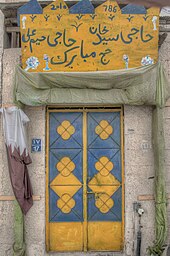
The houses of wealthy Qataris and Gulf residents are characterized by intricategypsumdecorations, often geometric or plant-based. Wooden doors and windows are similarly adorned, sometimes featuring colorful glass. Exterior walls might be decorated withrecessesandarches,while interior walls are plastered with inscribed gypsum panels andfriezes.Rawashin,or recessed niches, are commonly used for storing lamps and other items, adding both functional and decorative elements to the rooms.[5]
Water usage[edit]

In traditional Qatari houses, water was a vital resource carefully managed. Most homes, especially those belonging to wealthier families, featured awater wellwithin the courtyard. This well was the primary source of water for various domestic activities, including washing clothes, cleaning kitchenware, showering, and watering any plants within the courtyard. Washing and cooking were often done in the courtyard, taking advantage of the open space and natural light.[5]
Traditional Qatari houses featured simple but functionalbathrooms.These washrooms, often adjoined to each of the typically one to two main rooms of a house, were designed to ensure privacy while facilitating easy access to water from the well. All family members used the washrooms at all the times of the day for various purposes, including bathing, washing hands and feet, and other personal hygiene activities.[5]
Access[edit]
The architectural approach to accessing homes in Islamic societies varies widely, influenced by factors such as land availability, safety, and noise insulation. In Qatar, houses often open onto either acul-de-sacor a publicthoroughfare.These entrances usually incorporate a hairpin curve or right-angled turn to ensure privacy. The positioning of street doorways is carefully considered to avoid direct alignment with opposite entrances, enhancing privacy and preventing potential nuisances. Unlike other Islamic countries, where separate family entrances are common, most Qatari houses feature a single entrance with two doors: a large door for family access and a smaller one for guests.[5]
Madabis[edit]
The manufacturing ofdate syrupis one of the oldest industries in Qatar, dating back to at least the 17th century. Qatar's natural landscape can support only a few types of agriculture, anddate palmsare among them. The syrup was obtained by using a traditional date press calledmadabis ormadbasa.Due to its high-calorie content and nutrient density, it was a cheap and quick source of energy for the locals, particularly pearl divers.[9]
The construction of madabis employed traditional techniques reflective of the era. Utilizing locally available materials such as stones,limestone,sandstone,andcoral,craftsmen built these rectangular or square rooms with meticulous attention to detail. The outer walls, made of irregular stones, provided structural integrity, while inner walls crafted frombeachrocks(froush) added insulation. Traditional roofing methods, includingdanshilbeams andpalm fronds,ensured stability and protection from the elements.[10]
Mosques[edit]

Qatarimosques,much like their counterparts in the broader Persian Gulf region, exhibit a distinct architectural style characterized by a rectangular or square courtyard. This courtyard typically features aqiblagallery on one side, oriented towardsMecca,and covered with thin wooden logs known asdanshilor the more robustkhashab-al-murabaa.The gallery's walls include amihrabniche at its center, with apulpitniche (known asminbar) to the right.[11]
The courtyard's floor is often covered with seasand,locally abundant. Access to the courtyard is provided through three doors: one directly opposite the qibla gallery and two on the sides.Ablutionareas (maybaa) and minarets are strategically placed, usually at the northeast corner of the courtyard.[11]
The structural design of mosques in Qatar, dating from the late 18th to early 20th centuries, typically includes a wooden pulpit and minimal ornamental details. The mihrab niche, projecting from the qibla wall, may be covered with one or two domes. The ceiling structures incorporate lightweightbambooorreedlatticepatterns, providing a decorative yet functional element.[11]

Domesare a rare but notable feature in some Qatari mosques, such as the Abu Al-Qubaib mosque in Doha and Dukhan Masjid inDukhan,where they rest on square bases made of white stone and plaster. The gallery pillars are generally square in cross-section, although historical records indicate the existence of cylindrical columns in older mosques like those inZubarah.[11]
Windows in the qibla gallery are designed to allow ventilation and light, with wooden frames and iron bars providing security. The place of ablution, often a rectangular platform in the courtyard, includes awellfor ritual washing.[11]
Minaretsin Qatari mosques vary in shape, ranging from conical to cylindrical, and often includebalconiesfor themuezzinto call to prayer. These structures are typically adorned with plastered stone or wood railings and may feature decorative elements like small columns (hilya) on their domes.[11]
Forts[edit]
Qatar'sfortsrepresent an essential part of the country's architectural heritage, reflecting the strategic and defensive needs of different historical periods. Key sites include:
Murwab Fort[edit]
Located on the edge of a fertile lowland, approximately 15 km north ofDukhan,the excavated site ofMurwabFort can be found. This site included about 250 houses surrounding the fortress. Excavations revealed two mosques, numerous graves, and a well within the fortress courtyard.[12]Murwab Fort is the oldest known fort in the country and was built over the ruins of a previous fort which was destroyed by a fire.[13]It is rectangular in shape and is thought to have served as a palatial residence. The structure is similar to other palatial residences dating to theAbbasidperiod elsewhere in the Middle East.[14]A large courtyard with doors leading to twelve different rectangular rooms is in the center of the fort. The entrance, located on the north side, is 4.6 feet wide. Construction materials used for the wall were rocks and mud.[15]
Ar Rakiyat Fort[edit]

Situated 110 km from Doha, nearZubarah,Ar Rakiyat Fortis a typical desert fortress with a rectangular plan, four corner towers, and rooms along its northern, eastern, and western walls. Built from limestone and clay, it includes a freshwater well and was restored in 1988. The fortress dates back to between the 17th and 19th centuries, with archaeological evidence pointing to its use during the Abbasid period.[16]In 2022, using traditional building materials, the Department of Architectural Conservation ofQatar Museumscompleted the second restoration of the main structural building components including plastering, flooring, installation of a wooden ceiling, and doors.[17][18]
Ath Thaqab Fort[edit]
Located inAth Thaqabin northwest Qatar, Ath Thaqab Fort has a rectangular shape with four corner towers and a main entrance in the northern wall. The site includes a deep well and rooms around the courtyard. Built from limestone and clay, the fort likely dates to the 17th-19th centuries. The discovery of an Abbasid coin suggests an earlier historical context, though further excavations are required for a definitive answer.[19]
Al Wajbah Fort[edit]
Al Wajbah Fortis located in the locality ofAl WajbahinAl Rayyan,15 km west ofDoha.[20]The fort was built in 1882 and was the location of an important battle when the army of SheikhJassim bin Mohammed Al Thanisubdued theOttoman armyin 1893, in what would eventually be known as theBattle of Al Wajbah.[21]It was used as the residence ofHamad bin Abdullah Al Thaniat various periods. The fort's most prominent features are its four watchtowers.[22]Constructed from local stone and clay, it underwent restoration in the later 20th century.[23]
Zubarah Fort[edit]

Situated in the northwest of the Qatar Peninsula, theAl Zubara Fortwas built in 1938 and later restored. It has a square plan with four corner towers, high walls, and a central courtyard. The fortress features a mosque, galleries, and rooms with traditional wooden ceilings. It was initially constructed for border protection and later used by border guard forces.[24]It occupies theUNESCO World Heritagesite ofZubarah,and is considered the most notable attraction of the site.[25]
Al Koot Fort[edit]
One of Doha's few remaining military installations,Al Koot Fortwas built around 1925 to serve as a prison. It has a square plan with high walls and corner towers. The fortress was restored in 1978 and opened as an exhibition space in 1985. The design includes features for effective prisoner control and surveillance.[26]The fort was built in close proximity toSouq Waqifso that market thieves could easily be apprehended by officers on duty.[27]
Construction materials[edit]
Limestone[edit]

The Qatari Peninsula's surface is predominantlylimestone,covered with a thin layer ofsand,loess,andclay,forming the region's agricultural soils. Limestone has been a fundamental building material for centuries, used in the construction of houses, castles, towers, and mosques. Builders in Qatar and thePersian Gulfutilized various locally available stones, includingcoralslabs andpebbles.Coral slabs, obtained from coastal areas at low tide, were especially valued for their use in wall masonry,niches,and wall lintels. Another type of limestone, collected from the surface or cut from limestone hills, was used in construction but required covering withgypsumplasterfor durability.[28]
Coral slabs (frush)[edit]
Coralslabs are tiles measuring approximately 70 cm x 50 cm and 7 cm thick, sourced from coastal areas. They were prized for their suitability in building due to their availability and ease of use in construction, as corals are notably prevalent in Qatari waters which contain 48% of thecoral reefsin thePersian Gulf.[29]These slabs were primarily used for walls, niches, and other architectural features.[28]
Clay[edit]
Naturalclaywas abundant on some coastal terraces and served as an excellent bonding material inmasonry.It was used to coat the exterior walls of buildings and for makingmud bricks.To improve the clay's binding properties, choppedstrawwas added. Despite its advantages, clay was susceptible to weather conditions, particularly rain, necessitating periodic maintenance and protective measures.[28]
Gypsum (calcium sulfate)[edit]
Gypsum,locally sourced from areas likeAl Khor,Simaisma,andFuwayrit,was a crucial material in Qatari construction. It was used for plastering walls inside and outside buildings, making molds for ornaments, and enhancing the weather resistance of structures. Gypsum plaster covered masonry walls to prevent moisture penetration and decorate the exterior surfaces.[28]
Palm trunks[edit]

Palmtree trunks, after being cut and dried, were used extensively for roofing in traditional Qatari houses. These trunks provided structural support but were less load-bearing than other materials likedanshil.They were typically used in combination with otherroofingmaterials to create a stable and durable roof.[28]
Danshil (stabilized wood)[edit]
Danshil,a type ofstabilized wood,was commonly used in roofing, door lintels, and structural connectors in buildings. This material, imported fromEast Africa,was prized for its durability and resistance to weather conditions. It was often painted in bright colors and used decoratively in architectural elements.[28]
Mangroves[edit]
Mangrovestems, used in the form ofmats,were placed above danshil to create a base layer in roofing. This material was valued for its strength and durability, often used interchangeably with palm branches (duun) andbamboo(baszhil).[28]
Baszhil (bamboo)[edit]
Bamboo, known locally asbaszhil,was imported fromIndiaand East Africa and was used in making doors,chests,andcabinets.It was placed above danshil in roofing and sometimes painted in vibrant colors. Bamboo's long transportation distance did not significantly affect its cost, making it a popular material in the Persian Gulf.[28]
Duun (palm branches)[edit]
Palmbrancheswere gathered and joined to form large mats, used to cover danshil and baszhil. These mats provided additional support and protection in roofing structures, contributing to the overall stability and weather resistance of traditional Qatari buildings.[28]
Teak wood[edit]
Teakwood, known for its strength and durability, was imported from India and East Africa. It was used in various construction elements, including doors and furniture. Despite the long transportation distance, teak wood remained an affordable and popular material in the region.[28]
Tamarisk wood[edit]
Wood from thetamarisktree is prized for its use in the construction ofdoor frames,door bolts and back-of-door support frames.[30]
Modern architecture[edit]
Qatar in the past two decades has pinpointed its place on the world map with prominent global landmarks includingEducation Citywhich showcases architecture from numerous architects includingRem Koolhaaswho designed theQatar National Libraryduring 2018 and theQatar Foundationheadquarters back in 2014.[31]
Among Qatar's notable architects is Japanese architectArata Isozakiwho contributed towards designing countless buildings in Education City,[32]including theQatar National Convention Center(QNCC), the Liberal Arts and Science Building (LAS) and the Qatar Foundation Ceremonial Court.[31]
Qatar's art initiatives have expanded tremendously in recent years with the opening of massive great projects including theDoha Fire Stationwhich exhibits art at the heart of the city.[33]
Arts and museums have played a pivotal role in improving Qatar's tourism and inviting people to understand Qatar's history and heritage with the openings of theNational Museum of Qatar,Mathaf: Arab Museum of Modern Art,Msheireb Museumsand theMuseum of Islamic Arts.[33]
Her ExcellencySheikha Al-Mayassa bint Hamad bin Khalifa Al-Thanihas played a significant role in bringing art to Qatar,[34]particularly with the latest art installations at theHamad International Airport(HIA) showcasing pieces of work by numerous global artists in collaboration withQatar Museums Authority.[35]
Under the guidance of the CEO of Qatar Foundation,Sheikha Moza bint Nasser,[36]Education Cityhas become a home for modernistic buildings originating from worldwide architects contributing to the building of schools, universities, offices, and accommodations for the community.[31][37]
Examples of modern architecture[edit]
- Qatar National Convention Center(2011) designed byArata Isozaki[38]
- Qatar Foundation Ceremonial Court (2007) designed byArata Isozaki[39]
- Qatar Foundation Headquarters (2014) designed byRem Koolhaas[40]
- Northwestern University in Qatar(2017) designed byAntoine Predock[41]
- Carnegie Mellon University in Qatar(2008) designed byRicardo LegorretaandVictor Legorreta[42]
- Virginia Commonwealth University in Qatar (1998) designed by Mimar Consult[32]
- Weill Cornell Medical College in Qatar(2003) designed byArata Isozaki[43]
- Liberal Arts and Science building (2004) designed byArata Isozaki[44]
- Georgetown School of Foreign Service in Qatar (2010) designed byRicardo LegorretaandVictor Legorreta[45]
- Texas A&M University in Qatar (2007) designed byRicardo LegorretaandVictor Legorreta[46]
- Qatar Academy(1997) designed by Al Seed Consultant and Design Studio
- Awsaj Academy (2011) designed byJames Cubittand Partners
- Qatar Science and Technology Park (2009) designed byWoods Bagot[47]
- Strategic Studies Center (2014), also known as Think Bay designed byOffice for Metropolitan Architecture(OMA)
- Qatar National Library(2018) designed byRem Koolhaas[48]
- Sidra Medical and Research Center(2017) designed byPelli Clarke PelliArchitects[49]
- Al Shaqab(2019) designed byLeigh & Orange Architects[50]
- Student Center (2012) designed byRicardo LegorretaandVictor Legorreta
- Qatar Faculty of Islamic Studies (2014) designed by Mangera Yvars Architects[51]
- Mathaf: Arab Museum of Modern Art(2010) designed by Jean-Francois Bodin[52]
-
Qatar Faculty of Islamic Studies designed by Mangera Yvars Architects
-
Qatar FoundationHeadquarters designed byRem Koolhaas
-
Qatar National Librarydesigned byRem Koolhaas
References[edit]
- ^Mohammad Jassim Al-Kholaifi (2006).Traditional Architecture in Qatar.Doha: National Council for Culture, Arts and Heritage. p. 5.
- ^Mohammad Jassim Al-Kholaifi (2006).Traditional Architecture in Qatar.Doha: National Council for Culture, Arts and Heritage. p. 14.
- ^abcdMohammad Jassim Al-Kholaifi (2006).Traditional Architecture in Qatar.Doha: National Council for Culture, Arts and Heritage. pp. 13–14.
- ^abcMohammad Jassim Al-Kholaifi (2006).Traditional Architecture in Qatar.Doha: National Council for Culture, Arts and Heritage. p. 12.
- ^abcdefghiJaidah, Ibrahim; Bourennane, Malika (2010).The History of Qatari Architecture 1800-1950.Skira. pp. 19–23.ISBN978-8861307933.
- ^abcdEddisford, Daniel; Carter, Robert (26 October 2016)."The Vernacular Architecture of Doha, Qatar"(PDF).University College London. pp. 10–11.Retrieved25 May2024.
- ^Al-Muhannadi, Hamad (2012)."Chapter 9: The Traditional Roles of al-Majlis"(PDF).Studies in Qatari Folklore.Vol. 2. Heritage Department of theMinistry of Culture and Sports (Qatar).pp. 155–160.ISBN978-9927122316.Archived fromthe original(PDF)on 2019-03-06.Retrieved2024-04-27.
- ^Zyarah, Khaled (1997).Gulf Folk Arts.Translated by Bishtawi, K. Doha: Al-Ahleir Press. pp. 19–23.
- ^"Traditional Qatari Culture"(PDF).Qatar Tourism. p. 11.Retrieved28 April2024.
- ^Al Maashani, Musllam; Menon, Lakshmi Venugopal (May 2023)."Traditional Date Presses (madabis) in Qatar"(PDF).Gulf Studies Centre ofQatar University.Retrieved28 April2024.
- ^abcdefMohammad Jassim Al-Kholaifi (2006).Traditional Architecture in Qatar.Doha: National Council for Culture, Arts and Heritage. pp. 15–21.
- ^Mohammad Jassim Al-Kholaifi (2006).Traditional Architecture in Qatar.Doha: National Council for Culture, Arts and Heritage. p. 29.
- ^"History of Qatar"(PDF).Qatar Embassy in Thailand.Ministry of Foreign Affairs of Qatar. London: Stacey International. 2000.Retrieved9 January2015.
- ^"Settlements of Qatar".Qatar Museums.Retrieved3 August2015.
- ^Jaidah, Ibrahim; Bourennane, Malika (2010).The History of Qatari Architecture 1800-1950.Skira. p. 34.ISBN978-8861307933.
- ^Mohammad Jassim Al-Kholaifi (2006).Traditional Architecture in Qatar.Doha: National Council for Culture, Arts and Heritage. pp. 33–35.
- ^"Qatar Museums restores historic Al Rakiyat Fort".thepeninsulaqatar.com.2022-02-23.Retrieved2022-06-27.
- ^"Qatar Museums restores Al Rakiyat Fort in the north-east of the country".ILoveQatar.net.Retrieved2022-06-27.
- ^Mohammad Jassim Al-Kholaifi (2006).Traditional Architecture in Qatar.Doha: National Council for Culture, Arts and Heritage. pp. 35–37.
- ^"Visit Qatar".Archived fromthe originalon 18 October 2018.Retrieved10 November2016.
- ^"Al Wajbah Fort is a landmark in the history of Qatar and a tourist attraction".The Consulate General of the State of Qatar. 18 November 2022.Retrieved21 May2024.
- ^"Museums and forts".Ministry of Interior (Qatar). Archived fromthe originalon 26 January 2015.Retrieved4 July2015.
- ^Mohammad Jassim Al-Kholaifi (2006).Traditional Architecture in Qatar.Doha: National Council for Culture, Arts and Heritage. pp. 39–41.
- ^Mohammad Jassim Al-Kholaifi (2006).Traditional Architecture in Qatar.Doha: National Council for Culture, Arts and Heritage. p. 42.
- ^Sideridis, Dimitris (19 March 2019)."Al Zubarah: Vanished port is a gateway to Qatar's past".CNN.Retrieved21 May2024.
- ^Mohammad Jassim Al-Kholaifi (2006).Traditional Architecture in Qatar.Doha: National Council for Culture, Arts and Heritage. pp. 43–44.
- ^"Al Koot Fort".Explore Qatar.Retrieved21 May2024.
- ^abcdefghijMohammad Jassim Al-Kholaifi (2006).Traditional Architecture in Qatar.Doha: National Council for Culture, Arts and Heritage. pp. 105–108.
- ^"Qatar home to 48% of coral reefs in Arabian Gulf".The Peninsula Qatar. 17 October 2022.Retrieved21 May2024.
- ^Al-Obaidli, Saleh (2022).Ahşap Kapılar (Wooden Doors)(PDF)(in Turkish). Translated by Caymazoğlu, Yakup; Stiti, Mustapha. Doha: Al Waraq Printing Press. p. 15.
- ^abcJodidio, Philip. (2014).Education city: building foundations for the future.Doha: Qatar Foundation, Capital Projects Directorate.ISBN9788416142361.OCLC899565075.
- ^abBonilla, Leslie."Pearls, Souqs and Daggers: Inside the Hidden Elements of Education City Architecture".The Daily Q.Retrieved2023-01-17.
- ^ab"Visit Qatar | Discover a Unique Destination".www.visitqatar.qa.Retrieved2019-04-15.
- ^"HE Sheikha Al Mayassa Al Thani, Chairperson of Qatar Museums, is the Guest Editor of the November 2022 Issue of Vogue Arabia".Vogue Arabia.2022-11-01.Retrieved2022-12-02.
- ^Falconer, Morgan (2002-04-30).Butt, Hamad.Oxford Art Online. Oxford University Press.doi:10.1093/gao/9781884446054.article.t097571.
- ^"Her Highness Sheikha Moza bint Nasser | Qatar Foundation".www.qf.org.qa.Retrieved2022-11-30.
- ^"Explore Qatar's Education City".www.qf.org.qa.Retrieved2022-11-30.
- ^"Qatar National Convention Centre / Arata Isozaki".ArchDaily.2013-09-10.Retrieved2022-11-25.
- ^"Ceremonial Court and the Ceremonial Green Spine".visitqatar.com.Retrieved2022-11-25.
- ^"QF Conversation: Rem Koolhaas".Qatar Foundation.2017-11-08.Retrieved2022-11-25.
- ^"HBKU Carnegie Mellon / Legorreta + Legorreta".ArchDaily.2014-12-12.Retrieved2022-11-25.
- ^"Home in Qatar - Carnegie Mellon University | CMU".www.cmu.edu.Retrieved2023-01-17.
- ^"The Building | Weill Cornell Medicine - Qatar".qatar-weill.cornell.edu.Retrieved2022-11-30.
- ^"Liberal Arts and Science Building, Doha Qatar".www.archnet.org.Retrieved2023-01-17.
- ^"Georgetown University / LEGORRETA".ArchDaily.2018-11-05.Retrieved2023-01-17.
- ^"Texas A&M Engineering Building".www.qatar.tamu.edu.Retrieved2023-01-17.
- ^"Qatar / Woods Bagot".ArchDaily.2013-07-31.Retrieved2022-11-30.
- ^"Our Building | Qatar National Library".www.qnl.qa.Retrieved2022-11-30.
- ^"Sidra Medical and Research Center / Pelli Clarke Pelli Architects".ArchDaily.2019-05-02.Retrieved2022-11-30.
- ^"Al Shaqab Equestrian Academy".Leigh & Orange Architects.Retrieved2022-11-30.
- ^"Qatar Faculty of Islamic Studies by Mangera Yvars Architects | Universities".Architonic.Retrieved2022-12-02.
- ^"Mathaf: Arab Museum of Modern Art".universes.art.Retrieved2022-11-30.


